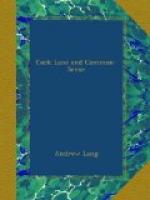Beautiful instances of common-sense explanations, occur in two stories of the last century, the St. Maur affair (1706), and the haunted house of Amiens, (1746). The author of ’Ce qu’on doit penser de l’aventure arrivee a Saint Maur,’ was M. Poupart, canon of St. Maur, near Paris. The good canon, of course, admits Biblical apparitions, which are miraculous, and admits hallucination caused by the state of the visual organs and by fever, while he believes in something like the Lucretian idea, that bodies, dead bodies, at least, shell off a kind of peel, which may, on occasion, be visible. Common ghosts he dismisses on grounds of common-sense; if spirits in Purgatory could appear, they would appear more frequently, and would not draw the curtains of beds, drag at coverlets, turn tables upside down, and make terrible noises, all of which feats are traditional among ghosts.
M. Poupart then comes to the adventure at St. Maur. The percipient, M. de S., was a man of twenty-five: his mother seems to have been a visionary, and his constitution is described as ‘melancholic’. He was living alone, however, and his mother has no part in the business. The trouble began with loud knocks at his door, and the servant, when she went to open it, found nobody there. The curtains of his bed were drawn, when he was alone in the room, and here, of course, we have only his evidence. One evening about eleven, he and his servants heard the papers on a table being turned over, and, though they suspected the cat, no cat could be found. When S. went to bed, the same noise persisted in his sitting-room, where the cat, no doubt, could easily conceal herself, for it is not easy to find a cat who has motives for not being found. S. again hunted for the animal, but only heard a great rap on the wall. No sooner had S. gone back to bed, than the bed gave a violent leap, and dashed itself against the wall: the jump covered four feet. He called his servants, who replaced the bed, but the curtains, in their sight, were drawn, and the bed made a wild rush at the fireplace. This happened again twice, though the servants held on gallantly to the bed. Monsieur S. had no sleep, his bed continued to bound and run, and he sent on the following day, for a friend. In that gentleman’s presence the leaps made by the bed ended in its breaking its left foot, on which the visitor observed that he had seen quite enough. He is said, later, to have expressed sorrow that he spoke, but he may have had various motives for this repentance.




